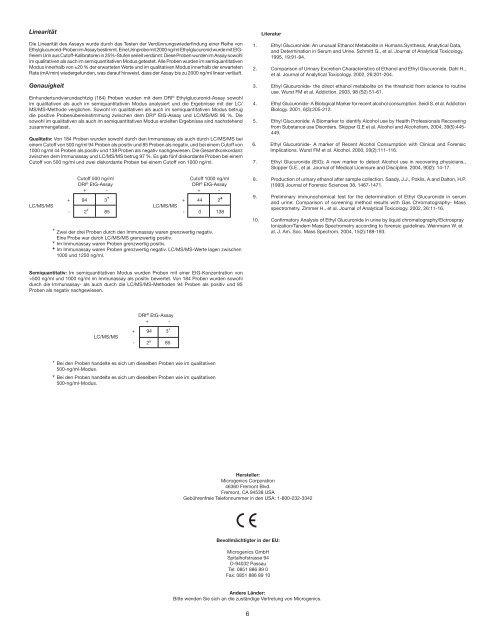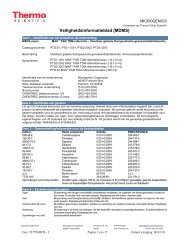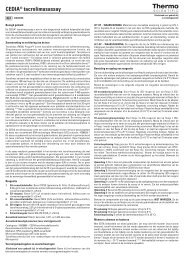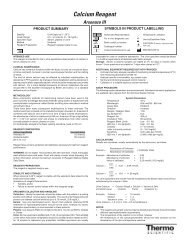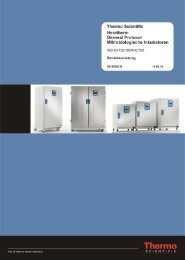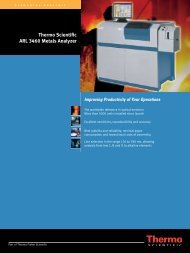DRI® Ethyl Glucuronide Assay - Fisher Scientific
DRI® Ethyl Glucuronide Assay - Fisher Scientific
DRI® Ethyl Glucuronide Assay - Fisher Scientific
Create successful ePaper yourself
Turn your PDF publications into a flip-book with our unique Google optimized e-Paper software.
Linearität<br />
Die Linearität des <strong>Assay</strong>s wurde durch das Testen der Verdünnungswiederfindung einer Reihe von<br />
<strong>Ethyl</strong>glucunorid-Proben im <strong>Assay</strong> bestimmt. Eine Urinprobe mit 2000 ng/ml <strong>Ethyl</strong>glucuronid wurde mit EtGfreiem<br />
Urin aus Cutoff-Kalibratoren in 25%-Stufen seriell verdünnt. Diese Proben wurden im <strong>Assay</strong> sowohl<br />
im qualitativen als auch im semiquantitativen Modus getestet. Alle Proben wurden im semiquantitativen<br />
Modus innerhalb von ±20 % der erwarteten Werte und im qualitativen Modus innerhalb der erwarteten<br />
Rate (mA/min) wiedergefunden, was darauf hinweist, dass der <strong>Assay</strong> bis zu 2000 ng/ml linear verläuft.<br />
Genauigkeit<br />
Einhundertundvierundachtzig (184) Proben wurden mit dem DRI ® <strong>Ethyl</strong>glucuronid-<strong>Assay</strong> sowohl<br />
im qualitativen als auch im semiquantitativen Modus analysiert und die Ergebnisse mit der LC/<br />
MS/MS-Methode verglichen. Sowohl im qualitativen als auch im semiquantitativen Modus betrug<br />
die positive Probenübereinstimmung zwischen dem DRI ® EtG-<strong>Assay</strong> und LC/MS/MS 96 %. Die<br />
sowohl im qualitativen als auch im semiquantitativen Modus erzielten Ergebnisse sind nachstehend<br />
zusammengefasst.<br />
Qualitativ: Von 184 Proben wurden sowohl durch den Immunassay als auch durch LC/MS/MS bei<br />
einem Cutoff von 500 ng/ml 94 Proben als positiv und 85 Proben als negativ, und bei einem Cutoff von<br />
1000 ng/ml 44 Proben als positiv und 138 Proben als negativ nachgewiesen. Die Gesamtkonkordanz<br />
zwischen dem Immunassay und LC/MS/MS betrug 97 %. Es gab fünf diskordante Proben bei einem<br />
Cutoff von 500 ng/ml und zwei diskordante Proben bei einem Cutoff von 1000 ng/ml.<br />
Cutoff 500 ng/ml Cutoff 1000 ng/ml<br />
DRI ® EtG-<strong>Assay</strong> DRI ® EtG-<strong>Assay</strong><br />
+ - + -<br />
+ 94 3 * + 44 2 ♠<br />
LC/MS/MS LC/MS/MS<br />
- 2 ¥ 85 - 0 138<br />
* Zwei der drei Proben durch den Immunassay waren grenzwertig negativ.<br />
Eine Probe war durch LC/MS/MS grenzwertig positiv.<br />
¥ Im Immunassay waren Proben grenzwertig positiv.<br />
♠ Im Immunassay waren Proben grenzwertig negativ. LC/MS/MS-Werte lagen zwischen<br />
1000 und 1250 ng/ml.<br />
Semiquantitativ: Im semiquantitativen Modus wurden Proben mit einer EtG-Konzentration von<br />
>500 ng/ml und 1000 ng/ml im Immunassay als positiv bewertet. Von 184 Proben wurden sowohl<br />
durch die Immunassay- als auch durch die LC/MS/MS-Methoden 94 Proben als positiv und 85<br />
Proben als negativ nachgewiesen.<br />
LC/MS/MS<br />
DRI ® EtG-<strong>Assay</strong><br />
+ -<br />
+ 94 3*<br />
- 2 ¥ 85<br />
* Bei den Proben handelte es sich um dieselben Proben wie im qualitativen<br />
500-ng/ml-Modus.<br />
¥ Bei den Proben handelte es sich um dieselben Proben wie im qualitativen<br />
500-ng/ml-Modus.<br />
6<br />
Literatur<br />
Hersteller:<br />
Microgenics Corporation<br />
46360 Fremont Blvd.<br />
Fremont, CA 94538 USA<br />
Gebührenfreie Telefonnummer in den USA: 1-800-232-3342<br />
Bevollmächtigter in der EU:<br />
Microgenics GmbH<br />
Spitalhofstrasse 94<br />
D-94032 Passau<br />
Tel: 0851 886 89 0<br />
Fax: 0851 886 89 10<br />
Andere Länder:<br />
Bitte wenden Sie sich an die zuständige Vertretung von Microgenics.<br />
1. <strong>Ethyl</strong> <strong>Glucuronide</strong>: An unusual Ethanol Metabolite in Humans.Synthesis, Analytical Data,<br />
and Determination in Serum and Urine. Schmitt G., et al. Journal of Analytical Toxicology.<br />
1995, 19:91-94.<br />
2. Comparison of Urinary Excretion Characteristics of Ethanol and <strong>Ethyl</strong> <strong>Glucuronide</strong>. Dahl H.,<br />
et al. Journal of Analytical Toxicology. 2002, 26:201-204.<br />
3. <strong>Ethyl</strong> <strong>Glucuronide</strong>- the direct ethanol metabolite on the threshold from science to routine<br />
use. Wurst FM et al. Addiction. 2003, 98 (S2) 51-61.<br />
4. <strong>Ethyl</strong> <strong>Glucuronide</strong>- A Biological Marker for recent alcohol consumption. Seidi S. et al. Addiction<br />
Biology. 2001, 6(3):205-212.<br />
5. <strong>Ethyl</strong> <strong>Glucuronide</strong>: A Biomarker to identify Alcohol use by Health Professionals Recovering<br />
from Substance use Disorders. Skipper G.E et al. Alcohol and Alcoholism, 2004, 39(5):445-<br />
449.<br />
6. <strong>Ethyl</strong> <strong>Glucuronide</strong>- A marker of Recent Alcohol Consumption with Clinical and Forensic<br />
Implications. Wurst FM et al. Alcohol. 2000, 20(2):111-116.<br />
7. <strong>Ethyl</strong> <strong>Glucuronide</strong> (EtG): A new marker to detect Alcohol use in recovering physicians.,<br />
Skipper G.E., et al. Journal of Medical Licensure and Discipline. 2004, 90(2): 14-17.<br />
8. Production of urinary ethanol after sample collection. Saady, J.J., Poklis, A.and Dalton, H.P.<br />
(1993) Journal of Forensic Sciences 38, 1467-1471.<br />
9. Preliminary immunochemical test for the determination of <strong>Ethyl</strong> <strong>Glucuronide</strong> in serum<br />
and urine: Comparison of screening method results with Gas Chromatography- Mass<br />
spectrometry. Zimmer H., et al. Journal of Analytical Toxicology. 2002, 26:11-16.<br />
10. Confirmatory Analysis of <strong>Ethyl</strong> <strong>Glucuronide</strong> in urine by liquid chromatography/Elctrospray<br />
Ionization/Tandem Mass Spectrometry according to forensic guidelines. Weinmann W. et<br />
al. J. Am. Soc. Mass Spectrom. 2004, 15(2):188-193.


